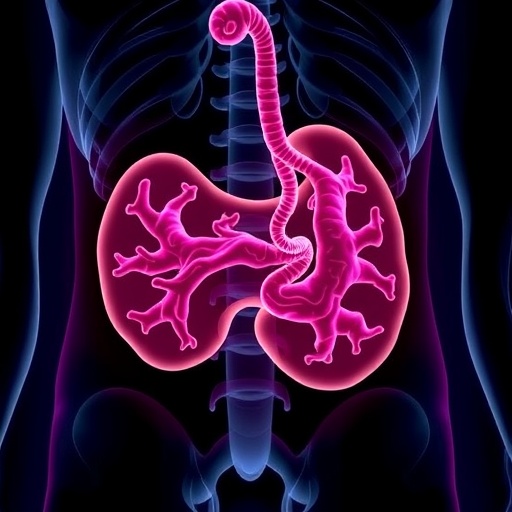A groundbreaking new epidemiological study has unveiled an unexpected surge in the incidence of appendiceal adenocarcinoma (AA), a rare form of appendix cancer, in recent American birth cohorts. Employing robust population-based cancer registry data from the National Cancer Institute’s SEER (Surveillance, Epidemiology, and End Results) Program, researchers conducted a comprehensive birth cohort analysis spanning several decades. Their findings reveal that individuals born after 1945—particularly those classified within Generation X and the Millennial generation—are experiencing a marked escalation in AA cases, a pattern heretofore unrecognized and alarming in its sharpness.
This novel research utilized a sophisticated age-period-cohort modeling approach to dissect temporal trends underlying appendiceal adenocarcinoma incidence from 1975 to 2019. The analysis incorporated 21 overlapping birth cohorts to elucidate how the risk for primary AA diagnoses evolved with birth year. The team identified 4,858 patients aged 20 years or older with histologically confirmed AA, encompassing all major subtypes including nonmucinous, mucinous, goblet cell, and signet ring cell carcinomas. These detailed histological distinctions were critical in understanding subtype-specific incidence trajectories.
The results demonstrated a striking pattern: compared to the 1945 birth cohort, AA incidence rates more than tripled in individuals born around 1980 and astonishingly quadrupled by the birth cohort of 1985. This exponential increase was consistent across different histologic subtypes, although the magnitude of rise varied somewhat among them. The temporal trends observed suggest a profound birth cohort effect, signaling that environmental, lifestyle, or possibly genetic influences introduced or intensified post-World War II may underlie this disturbing epidemiological shift.
Understanding why appendiceal cancer is becoming more prevalent among younger generations is paramount. The appendix, a small tubular organ historically considered vestigial, harbors glandular tissues susceptible to adenocarcinomatous transformation. Appendiceal carcinomas are notably rare, often diagnosed incidentally or at advanced stages due to nonspecific symptoms. This makes early detection challenging and raises concerns about future healthcare burdens as this rare malignancy rises in incidence.
The underlying etiological factors fueling this sharp increase in AA incidence remain unclear but are hypothesized to include shifts in environmental exposures, dietary patterns, microbiome alterations, or increased prevalence of inflammatory conditions of the appendix and gastrointestinal tract. The study authors emphasize the urgent need for more rigorous etiological research to unravel these associations, particularly investigations integrating molecular pathology and genomics with epidemiologic data to uncover mechanisms driving this cohort effect.
Physicians and oncologists, often unfamiliar with this rare malignancy, now face the imperative of increasing awareness and improving diagnostic scrutiny for appendiceal tumors. Current clinical guidelines rarely focus on AA due to its rarity; however, this rising trend among younger adults argues for revisiting screening protocols, educational initiatives, and potentially developing early detection biomarkers that might facilitate timely diagnosis and treatment.
During the study period, the meticulous SEER-based analysis accounted for fluctuations in diagnostic criteria, technological advancements in pathology, and cancer registry reporting improvements to ensure the validity of observed incidence trends. The consistent and robust increase across multiple independent subtypes and geographic regions strengthens the conclusion that this is a true epidemiologic phenomenon, not an artifact of improved detection alone.
This research bears significant implications for public health and oncology practice. With appendiceal adenocarcinoma cases ballooning in younger demographics, healthcare systems may anticipate an increased need for surgical oncology services, including appendectomy with oncologic resections and cytoreductive therapies frequently employed for mucinous variants. Moreover, the therapeutic landscape for AA, which remains limited by rarity and lack of tailored clinical trials, may require expedited research efforts targeting this malignancy.
In terms of pathology, the mucinous subtype of appendiceal adenocarcinoma is renowned for producing pseudomyxoma peritonei, a condition characterized by mucin accumulation within the abdominal cavity that complicates surgical management. The distinct clinical behavior and prognosis of various histologic subtypes necessitate subtype-specific investigation, as highlighted by the differential incidence increases reported in this birth cohort analysis.
The importance of this study extends beyond cancer epidemiology to provide a window into how changes in the environment, healthcare, or genomics can precipitate marked shifts in disease patterns in relatively short time spans. The quadrupling of a rare cancer incidence within a few generations signals a pressing call to the scientific community to prioritize research into modifiable risk factors and early detection strategies.
Given the projected future disease burden, public health messaging and physician education regarding appendiceal adenocarcinoma must be intensified. Greater awareness will enable clinicians to recognize suspicious presentations and refer patients for appropriate oncological evaluation and management, potentially improving outcomes for this historically insidious cancer.
In conclusion, the elucidation of birth cohort effects in appendiceal adenocarcinoma incidence across the United States unveils a new challenge confronting cancer epidemiologists and healthcare providers. The sharply rising incidence among Generation X and Millennials demands urgent multidisciplinary efforts spanning clinical awareness, etiological research, molecular investigation, and healthcare resource allocation. This study’s insights mark a pivotal advance in characterizing the evolving landscape of rare gastrointestinal cancers in modern cohorts.
Subject of Research: People
Article Title: Birth cohort effects in appendiceal adenocarcinoma incidence across the United States
News Publication Date: 10-Jun-2025
Web References: http://dx.doi.org/10.7326/ANNALS-24-02479
Keywords: Adenocarcinoma, Cancer risk, Oncology




